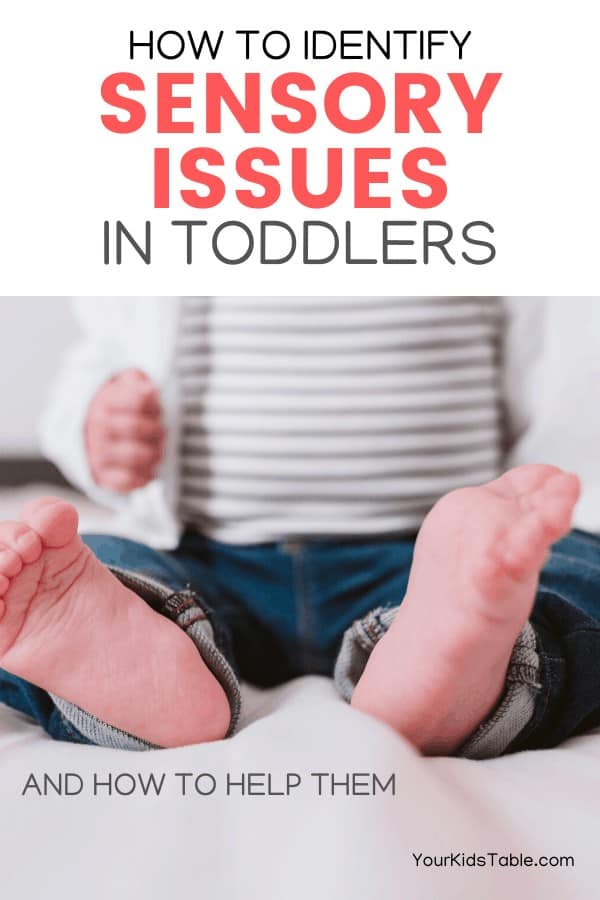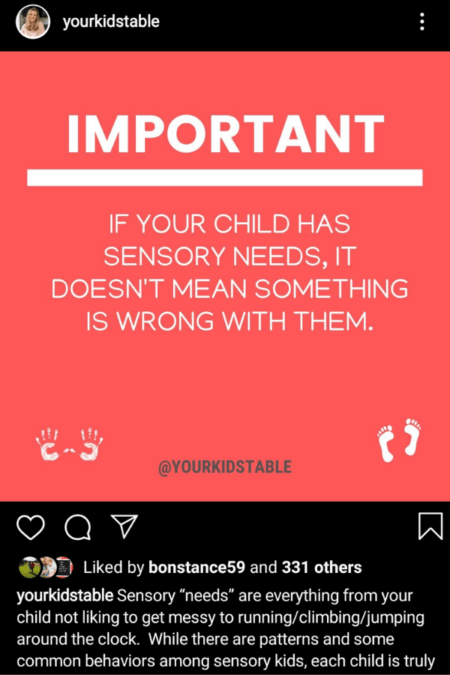It’s easy to miss signs of sensory issues in toddlers with their characteristic busyness and particularity, but these early signs for sensory sensitivity and sensory seeking can help you improve their sensory development and drastically decrease tantrums!
Got a toddler?
Then you know that they never stop, have poor attention, and tend to get into everything. Sometimes they do odd things like eat bits of dirt off the floor or rip their diaper off.
You have to keep an eye on a toddler because you never know what they’ll do next.
That’s why it’s easy to miss signs that they’re having some difficulty with their sensory processing – a crucial aspect of development that most parents have never heard of before.
When a child, even as young as a toddler, isn’t processing sensations well, they do things that are often confusing, upsetting, or frustrating to parents.
A quick Google search might tell you that your toddler has sensory issues…
Does Your Toddler Have Sensory Issues?
I don’t even like the term “sensory issues” because I don’t see these behavior as an issue. It’s so much more helpful and productive for everyone if we think of them as needs instead.
Technically we all have sensory issues. Each of us prefers certain flavors of food, music, and style of clothing.
As adults, we’ve learned to make accommodations for our preferences. For instance, I hate, and I mean hate, getting my clothes wet. It drives me up the wall. That is because of my brains unique sensory processing.
But, that’s just one of a few of my sensory needs. Mostly, my brain processes the sensations from my environment well. That’s not always the case though. Some people, children, and toddlers have lots of sensory needs. So many that it starts to affect their ability to learn, sleep, play, eat, and communicate.
While some kids benefit from a diagnosis of Sensory Processing Disorder, that’s not the case for many kids.
Imagine What it Would Be Like…
Think about it for a second, your toddler is bothered by the music you have playing, the tight jeans they have on, or that they haven’t been able to run around because they love to move. Their brain is stuck on getting the sensations it needs (or needs to avoid). There’s no brain power left for all those other important skills.
As you read through the signs below, notice how many are affecting your child’s daily life. If they have an impact on how they go through their day, then your child may have sensory needs. That doesn’t necessarily mean they need a diagnosis, and it definitely doesn’t mean something is wrong with them.
I shared this on Instagram recently, because it’s a HUGE misconception.
The good news is that sensory issues or needs in toddlers can dramatically improve because the brain is capable of learning – shifting, especially at this young age. And, once you see and understand your child’s sensory needs, you can help them. More on that later.
2 Types of Sensory Issues in Toddlers
Sensory processing can be a complex topic, but on a basic level, sensory issues boil down to types of needs:
1. Sensory Sensitivity – Toddlers avoid sensations like loud noises, bright lights, smells, tastes, textures of food, clothing, getting messy, swinging, climbing, and rough housing.
2. Sensory Seeking – Toddlers that need or seek out more sensations like running, climbing, jumping, hanging upside down, getting messy, smelling, licking, chewing, staring, spinning, touching, hugging, and making noise.
Some toddlers will predominantly or totally fit into one of these categories, but many kiddos will have a combination of both. Let’s take a closer look at some of the common sensory issues for both sensory seeking and sensory sensitivities that we see in toddlers.

Sensory Sensitivities in Toddlers
Initially, it may seem like a quirk, but when your child has extreme or consistent reactions to any of the following, it’s a clear sign that they’re having some sensory sensitivities that need addressed. The most important thing you can do is to NEVER force them to tolerate any of these sensations. But, for many, it’s important to slowly increase their interaction so they aren’t as sensitive.
This takes time.
Here are some of the most popular sensory issues in toddlers, there are many more possibilities that aren’t listed here:
-
- Scared of toilet flushing, sirens from a fire truck, or any other loud noises
-
- Strongly dislikes getting finger nails cut
-
- Fearful of swings
-
- Cries during rough housing play
-
- Avoids riding toys (cautious with new playground toys in general)
-
- Won’t play in a sand box or other messy textures
-
- Gags instantly on the texture of food {link to sensory processing and food]
-
- Freaks out during tooth brushing
-
- Hates being tickled
-
- Very aware of messy hands from crafts or food
-
- Gets upset when leaned backward for a diaper change or rinsing hair in the bath
-
- Can’t stand water on their face or getting hair washed
-
- Tantrums when wearing particular types of clothing (loves to be naked or in a diaper)
*Click the links above for tutorials on how to help kids that resist these necessary activities.
Signs of a Sensory Seeking Toddler
At the other end of the sensory processing spectrum is seeking behaviors. Toddlers that are seeking sensations can’t get enough. They have big needs because their brain is telling them “it’s not enough”. So they keep running, jumping, and rough housing without ever seeming to get tired of it.
They’re often described as the bull in the china shop.
Here are some of the other most common signs of seeking sensory in a toddler:
-
- Runs around often
-
- Spins in circles
-
- Hangs upside down off the couch
-
- Relentlessly asks to rough house
-
- Loves being tickled
-
- Touches everything in their environment
-
- Gets super messy and doesn’t seem to notice at all
-
- Prefers spicy or bold flavors of food
-
- Loves hard crunchy foods
-
- Still puts everything in their mouth
-
- Chews on random objects
-
- Holds food in their mouth (called pocketing)
-
- Stares at brightly colored books, TV shows, the ceiling fan, or other spinning objects for long periods of time
-
- Flaps hands in front of eyes
-
- Excessively smells things in their environment
-
- Licks random objects or even people
What to Do if Your Toddler Has Sensory Issues?
As I said earlier, sensory issues in your toddler does not mean there’s something wrong with your child. These days, we’re so much better at recognizing these behaviors and signs as related to sensory development than in the past.
That’s a good thing, because once you understand that sensory is the reason why your toddler never stops or is so sensitive, you’re in a position to help them.
I’m an occupational therapist, and use a simple, no-stress sensory diet to help toddlers with sensory issues. A sensory diet isn’t about what they’re eating though, it’s about giving them the sensations they need so their system is balanced.
When they’re balanced or regulated they can listen better, pay attention, learn, play with others, and communicate.
All of those things go out the window when they’re focused on running or avoiding the messy spaghetti they’re about to eat. If the sensory needs get big enough, they’ll even go into a fight or flight response, also called a sensory meltdown.
You may have seen this in your toddler if they get very angry and become aggressive. Or, if they take off to retreat when the sensations are too much.
2 Ways to Help Your Toddler With Sensory Issues
To help a toddler that’s having a sensory sensitivity, you’ll need a lot of patience. If they won’t go in the sandbox, will they sit outside of it on a towel, and dip a shovel inside? This is a baby desensitization step. You might work on that for a few days or a few weeks before you work on digging with a smaller shovel or touching the sand with their fingertip.
This is an example of helping them with their sensory need and giving them a sensory diet.
Or, if your child is seeking a sensation, you’ll think about how to give them that experience as they need it. For example, let’s say that you’re going to great Aunt Betsy’s for dinner, but your toddler literally climbs the furniture like a monkey. This upsets Aunt Betsy, and while you explain sensory to her, you’d also like your child to be calmer in this setting.
To do that, you’d experiment with giving him lots of time before you left for her house to run around the yard, swing, or jump on the couch (with supervision).
Watch for his response.
Did he calm down? Does he need more time to jump/run/climb? If so, experiment and adjust the next time. This movement can give him what he needs to regulate his sensory system and improve his attention.
This too is just one way to use a sensory diet. To learn more about implementing one easily, check out our free workshop.
Lastly, if you’ve read this article and feel that your child has a lot of sensory needs, you may want to consider an evaluation from a occupational therapist. If you’re not sure, call some local facilities and tell them about your child. They’ll let you know if sensory integration therapy could be helpful.
However, many kids have mild to moderate sensory needs and don’t need more intensive therapy. Instead, understanding their needs and how to support them can improve their sensory needs!
To get more sensory tips and support come follow us on Instagram, click here!
More on Sensory Issues in Toddlers
17 Extraordinary Sensory Activities That Help Toddlers Learn and Grow
Top 10 Sensory Swings for Kid’s Development and Sensory Processing
Does Your Baby or Toddler Keep Spitting Out Their Food? Try This
Alisha Grogan is a licensed occupational therapist and founder of Your Kid’s Table. She has over 15 years experience with expertise in sensory processing and feeding development in babies, toddlers, and children. Alisha also has 3 boys of her own at home. Learn more about her here.


